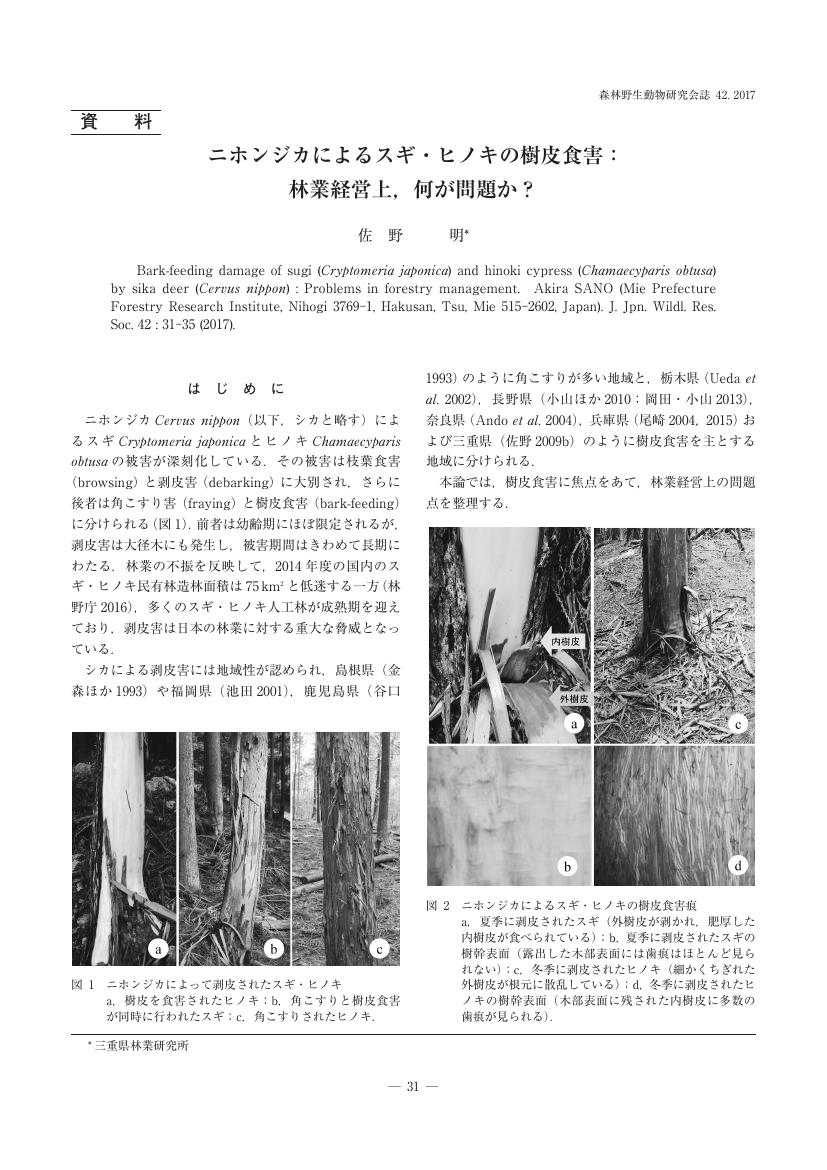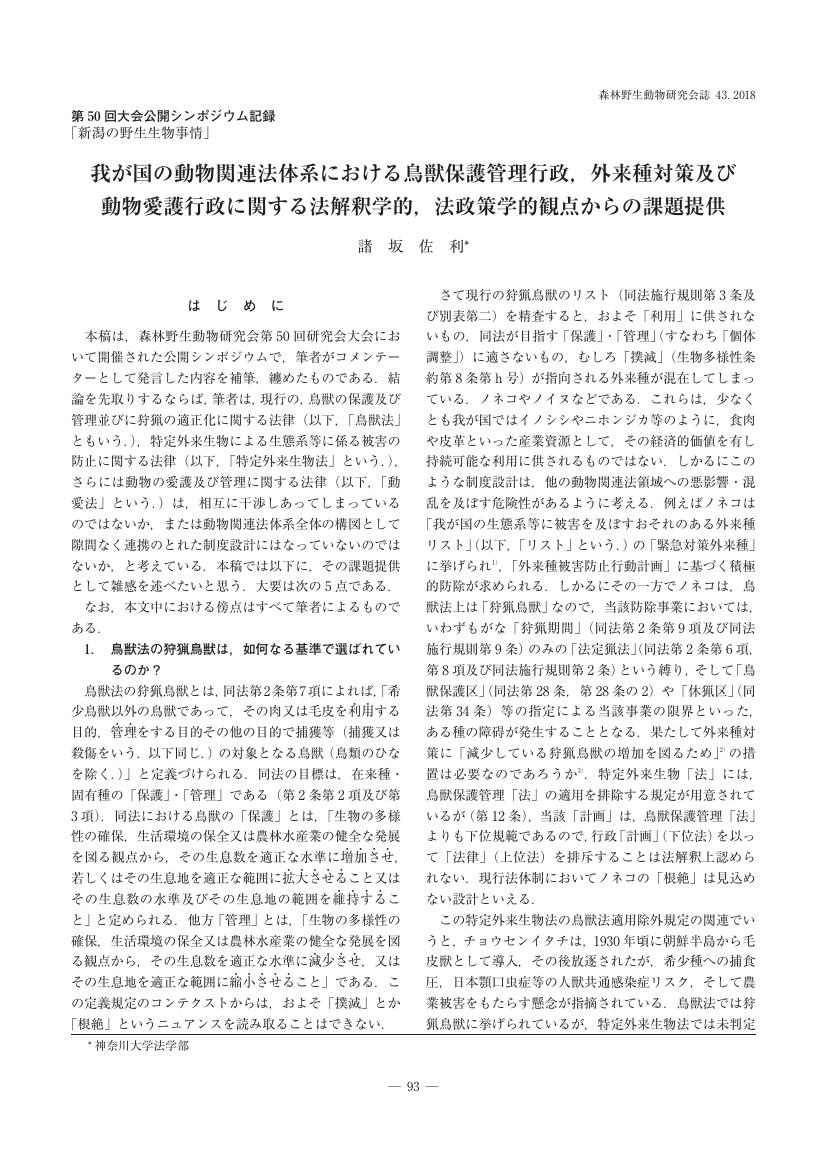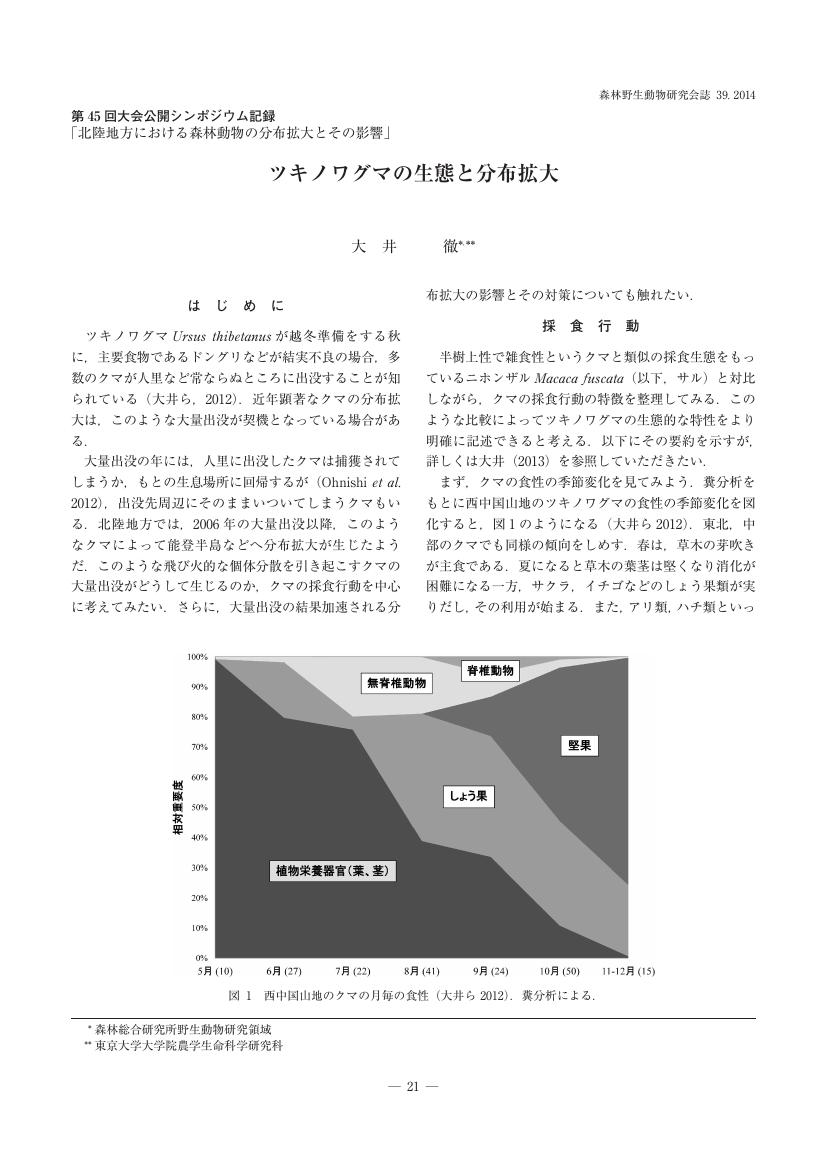1 0 0 0 OA ニホンジカによるスギ・ヒノキの樹皮食害:林業経営上,何が問題か?
- 著者
- 佐野 明
- 出版者
- 森林野生動物研究会
- 雑誌
- 森林野生動物研究会誌 (ISSN:09168265)
- 巻号頁・発行日
- vol.42, pp.31-35, 2017-03-30 (Released:2020-04-01)
- 参考文献数
- 34
- 著者
- 鉄谷 龍之 西山 忠良 高野 真矢 石井 信夫 安藤 元一
- 出版者
- 森林野生動物研究会
- 雑誌
- 森林野生動物研究会誌 (ISSN:09168265)
- 巻号頁・発行日
- vol.43, pp.19-25, 2018-03-30 (Released:2021-04-01)
- 参考文献数
- 23
静岡県伊東市に生息する特定外来生物アムールハリネズミErinaceus amurensisについて,2007年,2008年,および2012年の6月から11月までの期間に,手捕りによってゴルフ場3カ所と公園1カ所で捕獲された113個体の胃内容物を分析した.胃内容物は地表性の昆虫類が大部分を占め,1個体当たりの餌品目数(平均±SD)は3.2±1.3であった.出現頻度では,芝生の害虫としてよく見られるスジキリヨトウSpodoptera depravataの幼虫をはじめとするチョウ目Lepidoptera(81.4%)が最も多く,オサムシ科Carabidae(15.0%),シデムシ科Silphidae(11.5%),コガネムシ科Scarabaeidae(17.7%)などのコウチュウ目Coleoptera(74.3%),バッタ目Orthoptera(20.4%),ハチ目Hymenoptera(15.9%)がそれに次いだ.胃内容物中におけるコウチュウ目とチョウ目の幼虫の増減と発生の季節変動が同様であることから,アムールハリネズミに餌の選好性はないと考えられる.捕獲時間ごとの胃内容物の乾燥重量は夜間を通じて増加したことから,本種は夜間を通じて採食していると考えられる.
- 著者
- 河原 淳
- 出版者
- 森林野生動物研究会
- 雑誌
- 森林野生動物研究会誌 (ISSN:09168265)
- 巻号頁・発行日
- vol.31, pp.11-18, 2005-12-25 (Released:2017-10-03)
I collected 7 individual of Sorex minutissimus hawkeri in the wetland of in Kiritappu Hamanaka-cho and in the sand area Kenbokuki Island. The capture record in Kenbokki is since S. m. hawkeri was already caught in Hichirippi, Hamanaka in 1985. S. m. hawkeri was captured until now was Wetland and a forest, this time they were caught in the sand area for the first time. The captures of this species were also recorded in Kunashiri, and Etorofu islands near Hokkaido. However the capture was no record in such a small island as Kenbokuki Island. S. m. hawkeri was observed eating beach fleas in a cage.
- 著者
- 河原 淳
- 出版者
- 森林野生動物研究会
- 雑誌
- 森林野生動物研究会誌 (ISSN:09168265)
- 巻号頁・発行日
- vol.31, pp.19-24, 2005
- 被引用文献数
- 1
Sorex minutissimus hawkeri of 9 individuals was caught in August, 2004 and September, 2004 on Kenbokki Island of Hokkaido. Nine individuals were caught, and among those, five individuals were alive and were caught. S.m. hawkeri was caught in the range from the position of 5 m to 15 m from the coastline. S.m. hawkeri made space between grass and was resting there. S.m. hawkeri rose and fell frequently to the grass upper part. Moreover, S.m. hawkeri might not move for tens of seconds to several minutes, where it is the grass upper part and the head is hung down downward.
- 著者
- 諸坂 佐利
- 出版者
- 森林野生動物研究会
- 雑誌
- 森林野生動物研究会誌 (ISSN:09168265)
- 巻号頁・発行日
- vol.43, pp.93-99, 2018-03-30 (Released:2021-04-01)
- 参考文献数
- 6
1 0 0 0 OA シカが生物多様性に及ぼす影響:チョウ類の事例から
- 著者
- 中村 康弘
- 出版者
- 森林野生動物研究会
- 雑誌
- 森林野生動物研究会誌 (ISSN:09168265)
- 巻号頁・発行日
- vol.41, pp.73-76, 2016-03-30 (Released:2019-09-21)
- 参考文献数
- 13
- 著者
- 藤巻 裕蔵
- 出版者
- 森林野生動物研究会
- 雑誌
- 森林野生動物研究会誌 (ISSN:09168265)
- 巻号頁・発行日
- vol.35, pp.1-6, 2010
1976〜2009年の4月下旬〜7月上旬(高標高地では7月下旬)に北海道中部・南東部の823区画(5km×4.5km),調査路928か所でシジュウカラとゴジュウカラの生息状況を調べた.シジュウカラが出現したのはそれぞれ505区画(61%),548か所(59%),ゴジュウカラが出現したのは333区画(40%),359か所(39%)であった.シジュウカラの生息環境別の出現率は常緑針葉樹林53%,針広混交林52%,落葉広葉樹林77%,カラマツ林71%,農耕地・林68%,農耕地43%で,住宅地71%であった.ゴジュウカラの出現率はそれぞれ67,63,60,50,33,16,14%であった.標高別の出現率はシジュウカラについては200m以下では60%,201〜400mでは65%,401〜600mでは61%,601〜800mでは40%,801m以上では12%,ゴジュウカラについてはそれぞれ33,47,68,36,24%であった.調査路2km当たりの平均観察個体数は,シジュウカラでは常緑針葉樹林0.5±0.5(平均値±標準偏差),針広混交林0.8±1.1,落葉広葉樹林1.0±1.1,カラマツ林1.0±1.1,農耕地・林0.8±1.2,農耕地0.3±0.8,住宅地0.8±0.8.ゴジュウカラではそれぞれ0.5±0.9,0.6±0.9,0.5±0.9,0.1±0.3,0.2±0.4,0.04±0.23,0.03±0.17であった.
1 0 0 0 北海道中部・南東部におけるコゲラとコアカゲラの繁殖期の生息状況
- 著者
- 藤巻 裕蔵
- 出版者
- 森林野生動物研究会
- 雑誌
- 森林野生動物研究会誌 (ISSN:09168265)
- 巻号頁・発行日
- vol.40, pp.1-6, 2015
<p>1976~2014年の4月下旬~7月上旬(高標高地では~7月下旬)に北海道中部・南東部の900区画(4.5km×5km),調査路1009か所でコゲラ<i>Dendrocopos kizuki</i>とコアカゲラ<i>D. minor</i>の生息状況を調べた.出現した区画数と調査路数は,コゲラで239区画(30%),285か所(28%),コアカゲラで26区画(3%),27か所(3%)で,前者で有意に多かった.コゲラがおもに山間部に生息するのに対し,コアカゲラは平野部と平野から山間部にかけて生息する.生息環境別の出現率は,コゲラでは常緑針葉樹林で33%,針広混交林で54%,落葉広葉樹林で56%,カラマツ人工林で20%,農耕地・林で22%,農耕地で5%,住宅地で2%であった.コアカゲラでは落葉広葉樹林で1%,農耕地・林で7%,農耕地で2%で,それ以外の環境では観察されなかった.コゲラの標高別出現率は,200m以下で23%,201~400mで37%,401~600mと601~800mで50%,801m以上で14%で,コアカゲラでは200m以下で4%,201~400mで2%であった.各生息環境における2km当りの平均観察個体数は,コゲラでは0.02~0.6羽で,コアカゲラでは0.01~0.1羽と少なかった.</p>
1 0 0 0 北海道中部・南東部におけるマミジロとトラツグミの繁殖期の分布
- 著者
- 藤巻 裕蔵
- 出版者
- 森林野生動物研究会
- 雑誌
- 森林野生動物研究会誌 (ISSN:09168265)
- 巻号頁・発行日
- vol.39, pp.1-6, 2014
<p>1976~2013年の4月下旬~7月上旬(高標高地では~7月下旬)に北海道中部・南東部の887区画(4.5km×5km),調査路996か所でマミジロ<i>Zoothera sibirica</i>とトラツグミ<i>Zoothera dauma</i>の分布を調べた.これらが出現した区画数と調査路数は,マミジロで45区画(5%),48か所(5%),トラツグミで260区画(29%),279か所(28%)で,後者で有意に多かった.マミジロが山地だけに生息するのに対し,トラツグミは山地と一部平野にも生息する.生息環境別の出現率は,マミジロではハイマツ林で0%,常緑針葉樹林で7%,針広混交林で21%,落葉広葉樹林で6%,農耕地・林で1%,それ以外の環境では0%であった.トラツグミではハイマツ林で0%,常緑針葉樹林で60%,針広混交林で54%,落葉広葉樹林で46%,カラマツ人工林で44%,農耕地・林で22%,農耕地で11%,住宅地で2%であった.マミジロの標高別出現率は,200m以下で1%,201~400mで7%,401~600mで17%,601~800mで25%,801m以上で17%で,トラツグミの標高別出現率はそれぞれ25,42,30,10,17%で,マミジロの方が高標高に生息する.</p>
1 0 0 0 北海道芽室町北伏古地区における翼手目の捕獲記録.第2報
- 著者
- 柳川 久 前田 敦子 谷崎 美由記 赤坂 卓美
- 出版者
- 森林野生動物研究会
- 雑誌
- 森林野生動物研究会誌 (ISSN:09168265)
- 巻号頁・発行日
- vol.29, pp.19-24, 2003
A bat survey was carried out during July, August and September 2002, at Kitafushiko (42°52'N;143°8'E), Memuro-cho, in central Hokkaido. Five species of bats were caught in mist nets: Myotis macrodactylus, M. daubentonii, M. frater, Eptesicus nilssonii and Nyctalus aviator. M. frater used tree hollows for their daytime and maternity roosts during July and August.
1 0 0 0 OA 福井県におけるシカによる森林被害について
- 著者
- 酒田 真澄美
- 出版者
- 森林野生動物研究会
- 雑誌
- 森林野生動物研究会誌 (ISSN:09168265)
- 巻号頁・発行日
- vol.39, pp.25-28, 2014-03-28 (Released:2017-04-26)
- 参考文献数
- 11
1 0 0 0 OA ヒグマの越冬地での人の安全対策
- 著者
- 門崎 允昭 河原 淳 小澤 良之
- 出版者
- 森林野生動物研究会
- 雑誌
- 森林野生動物研究会誌 (ISSN:09168265)
- 巻号頁・発行日
- vol.21, pp.23-29, 1995 (Released:2017-10-03)
The authors investigated five injury incidents and one death incident of humans due to attacks by brown bears (Ursus arctos)during hibernation , occurring in Hokkaido Japan during the 26 years from 1970 through to 1995. Details and characteristics of these bear attack incidents and countermeasures to prevent attacks and injury are described within. The reason bears attack while they are hibernating is to protect their den from possible human intrusion. If they scene a possible threat close to their den they will leave their den to drive off the perceived threat. A hibernation den is a tunnal cave dug by bears in a mountain slope. Bears in Hokkaido usually start hibernating from late November to late December and finish hibernating from late March to early May. It has been observed that in general dens with a larger than average entrance have been a feature in relation to attacks on humans. In the one reported case of a human death due to a bear attack in Hokkaido, occurred in early December very early in the bears hibernation. The bear stood up and attacked with its hand claws. All other reported attacks did not lead to death. These attacks all occurred after late February. This is past the half way point of the bears hibernation. The bears had used up so much energy in keeping warm during winter the bears therefore did not have enough energy to stand up and attack. They attacked their human victims only with their teeth. Therefore it appears in order to minimize injury from bear attacks. It is better to start work in bears hibernating areas after late February, which is past the half way term point of hibernation. Bears usually don't have enough energy to stand up and attack past the half way point of their hibernation. Standard safety measures to help prevent bear attacks on humans, people shoud carry a sound-making instrument, such as a whistle or a bell, and a hatchet(a big knife) for self-protection when entering an area presumed to be a bears habitat. While walking, people should blow or rattle the sound-making instrument, or raise their voices in order to avoid encountering bears unexpectedly. Because bears dislike hibernating in a place where the environment has been artificially changed, minor modifications to the environment are effective in preventing bears from making dens. Bears lurking obstinately in their den should not be killed. People can safely work around a bear's den if they remain 50 to 100 m away from it. Bears often use several different dens. Therefore, bears escaping from a den due to the intrusion of humans usually enter another den, and it is not necessary to chase and kill them. When encountering a bear people should never run to escape or feign death as the bear is sure to attack. The best actions are to stand, be confident and shout at the bear in a loud voice. Such actions are often successful and the bear will leave. If a bear should actually attack the best response is to deliver a blow of a hatchet on any part of the bears body. This will increase the chance of survival.
- 著者
- 門崎 允昭
- 出版者
- 森林野生動物研究会
- 雑誌
- 森林野生動物研究会誌 (ISSN:09168265)
- 巻号頁・発行日
- vol.25.26, pp.65-70, 2000 (Released:2017-10-03)
On May 10, a 47 year old fisherman was killed and eaten by a sole, 2 year 3 month old male bear (Ursus arctos). On the following day in the same area, two women (30 and 50 years old) were out collecting edible wild plants when they were attacked and wounded by the same bear that killed the fisherman. The bear had clearly eaten the fisherman's facial, head and throat muscles, right arm, right pectoral muscles and ribs. The facts that the bear had attacked, dragged the man to a comfortable place and then ate, suggests that the bear's attacking purpose was for food. The two women had come within a few meters of the bear and were attacked by the bear when trying to flee. Both women were injured in the head region. The first woman attacked was the 50 year old woman. She fought off the attack by repeatedly beating the bear with a stick. The bear then attacked the younger woman but was astonishingly driven off when the elder woman produced a large sound with her car horn. The bear had evidently attacked the women with the purpose of repelling them from his nearby food source ; the fisherman's corpse. In the past 30 years, the incidence of bear attacks on people, other than hunters, has been limited to either sole young bears or dam with offspring. The young bears were mostly two or three years old, however in some rare cases, the bear has been four years old. The causes of these attacks may be divided into three categories, i.e. to eat, to repel or to play. The incidents mentioned above fit within these categories. In the case of the fisherman, it may have been possible for him to have safely escaped if he had repelled the attack with a hatchet that may be carried legally.
1 0 0 0 OA 2000年度に北海道で発生したヒグマによる人身事件4件
- 著者
- 門崎 允昭
- 出版者
- 森林野生動物研究会
- 雑誌
- 森林野生動物研究会誌 (ISSN:09168265)
- 巻号頁・発行日
- vol.27, pp.17-19, 2001 (Released:2017-10-03)
The first incident involved a lone, two-year-old bear in play. The victim attempted to escape from the bear by climbing a tree. The bear followed the victim up a tree. The man was able to beat off the bear by hitting it in the face with a branch. The second incident involved an attack from a bear that was protecting its young from an approaching person. The attack was successfully fended off when the victim retaliated with sickle and hand saw. The third and fourth incidents involved retaliatory attacks by bears which were shot by hunters. The third victim is in critical condition. The fourth victim died. In both cases the bear was acting in retaliation of being attacked.
1 0 0 0 OA 市街地に出没するヒグマ・エゾシカの状況と対応
- 著者
- 立木 靖之
- 出版者
- 森林野生動物研究会
- 雑誌
- 森林野生動物研究会誌 (ISSN:09168265)
- 巻号頁・発行日
- vol.40, pp.41-44, 2015-03-30 (Released:2018-04-01)
1 0 0 0 OA ツキノワグマの生態と分布拡大
- 著者
- 大井 徹
- 出版者
- 森林野生動物研究会
- 雑誌
- 森林野生動物研究会誌 (ISSN:09168265)
- 巻号頁・発行日
- vol.39, pp.21-24, 2014-03-28 (Released:2017-04-26)
- 参考文献数
- 9
- 著者
- 平田 敏彦
- 出版者
- 森林野生動物研究会
- 雑誌
- 森林野生動物研究会誌 (ISSN:09168265)
- 巻号頁・発行日
- vol.28, pp.69-72, 2002
1 0 0 0 OA 戸河内町でのツキノワグマによる人身事故
- 著者
- 江草 真治 門崎 允昭 河原 淳
- 出版者
- 森林野生動物研究会
- 雑誌
- 森林野生動物研究会誌 (ISSN:09168265)
- 巻号頁・発行日
- vol.18, pp.48-49, 1991 (Released:2017-10-03)
At about 10:30 a.m. on May 3, 1991 80 year old Mr.OOE was attacked by a sole black bear Ursus thibetanus in national forest in Togouchi, Hirosima, and injured on the left leg and right side of the head. The causes of bear attacks on humans are divided into three areas, i. e. to eat, to drive away and for sport or excitement. The motive for the attack in this incident seems either to drive the person away or to have sport with him. People entering bear habitat should carry a sound-making instrument, and a hatchet for self-protection.
1 0 0 0 OA 鹿角市でのツキノワグマによる人身事故
- 著者
- 成田 祥夫 河原 淳
- 出版者
- 森林野生動物研究会
- 雑誌
- 森林野生動物研究会誌 (ISSN:09168265)
- 巻号頁・発行日
- vol.20, pp.8-12, 1994 (Released:2017-10-03)
At about 4:30 a.m. on August 18, 1991, Mrs. Ueda (67 years of age) was attacked by a sole black bear Ursus thibetanus on a mountain path in Kazuno, Akita. As Mrs. Ueda was taking a mountain path which is a shortcut to the field, she was suddenly attacked by the black bear and injured on the left side of her face. Two important safety factors had been overlooked. In spite of warnings of frequent sightings of bears Mrs.Ueda took the mountain path. A garbage dump, Which is known to attract bears, had been made near the field.
1 0 0 0 OA 日本産樹上性リス類による森林被害
- 著者
- 浅利 裕伸 柳川 久 安藤 元一
- 出版者
- 森林野生動物研究会
- 雑誌
- 森林野生動物研究会誌 (ISSN:09168265)
- 巻号頁・発行日
- vol.39, pp.11-16, 2014-03-28 (Released:2017-04-26)
- 参考文献数
- 32
日本産樹上性リス類による森林被害に関する論文として,論文検索サイトによりキタリス(Sciurus vulgaris)およびタイリクモモンガ(Pteromys volans)各1編,ニホンリス(S. lis)3編,ムササビ(Petaurista leucogenys)9編の4種14編を収集した.ムササビによるスギ(Cryptomeria japonica)やヒノキ(Chamaecyparis obtusa)の被害は餌植物の不足によるもの,ニホンリスによるキノコ類のほだ木の剥皮害は材内幼虫を捕食するためと考えられた.シカやネズミ類などと比べて樹上性リス類による被害は小さく,むしろ樹上性リス類の健全な生息環境を維持するための休息・繁殖場所となる樹洞の維持,通年多様な食物を提供する針広混交林の創出,移動を妨げない連続した森林配置などの樹上性リス類に適した森林管理が,生態系の改善に向けて重要な課題と考えられる.





